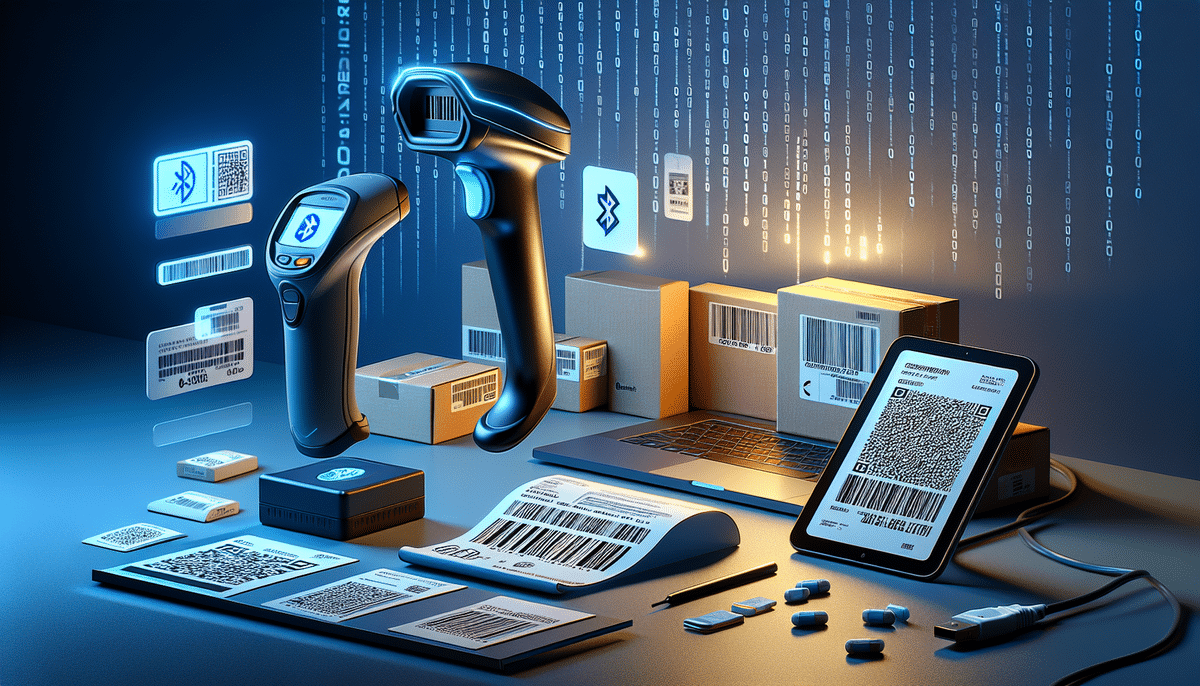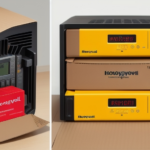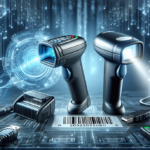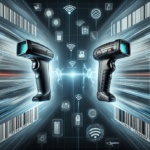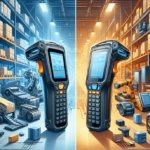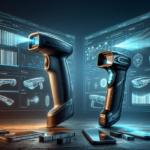Inateck BCST-70 vs Zebra Symbol LS2208: Comprehensive Barcode Scanner Comparison 2024
Barcode scanners are indispensable tools across various industries, including retail, logistics, and healthcare. They enable businesses to enhance operational efficiency by swiftly and accurately scanning barcodes on products, inventory, and shipping labels. However, not all barcode scanners offer the same features and performance. This article provides an in-depth comparison of two popular models—the Inateck BCST-70 and the Zebra Symbol LS2208—to help you determine which scanner best fits your business needs.
Overview of Barcode Scanners and Their Importance
Barcode scanners have revolutionized the way businesses handle inventory management, sales processing, and information tracking. According to a 2023 industry report, the global barcode scanner market is expected to reach $28 billion by 2025, driven by the increasing demand for automation and efficient data capture solutions.
These devices improve efficiency and accuracy in tasks that were previously manual and error-prone. For instance, in inventory management, a simple scan can update stock levels, track product movement, and reorder supplies automatically. In retail settings, barcode scanners expedite the checkout process, reducing wait times and enhancing customer satisfaction.
In the healthcare sector, barcode scanners are critical for tracking patient information, administering medications, and managing medical equipment. They help minimize medication errors, ensure accurate patient data management, and streamline the inventory of medical supplies, thereby improving overall patient safety and operational efficiency.
Inateck BCST-70: In-Depth Review
Key Features
- Connectivity: Wireless Bluetooth connectivity allows seamless pairing with smartphones, tablets, and computers.
- Scanning Speed: Capable of 220 scans per second, ensuring rapid data capture.
- Scanning Distance: Effective up to 35 feet, ideal for large warehouses and expansive retail spaces.
- Barcode Compatibility: Supports 1D, 2D, and QR barcodes, offering versatility for various applications.
- Durability: Built to withstand drops from up to 6.6 feet.
- Battery Life: Long-lasting battery with up to 15 days on a single charge.
Performance and Usability
The Inateck BCST-70 excels in environments requiring high mobility and versatility. Its ability to scan barcodes from digital screens is particularly advantageous for businesses utilizing mobile point-of-sale systems. The ergonomic design ensures comfortable use during extended scanning sessions.
However, some users have reported challenges with device connectivity, citing unclear instructions during the pairing process. Addressing this issue through improved documentation or user guides could enhance the overall user experience.
For more details, visit the Inateck BCST-70 product page.
Zebra Symbol LS2208: In-Depth Review
Key Features
- Connectivity: Wired USB connection ensures a stable and reliable link without the need for pairing.
- Scanning Speed: Achieves 100 scans per second, suitable for high-traffic environments.
- Scanning Distance: Effective up to 17 inches, optimized for close-range scanning.
- Barcode Compatibility: Supports 1D barcodes, ideal for linear barcode applications.
- Durability: Built to endure drops from up to 5 feet with an IP42 sealing rating for dust and water resistance.
- Ergonomics: Lightweight design with an ergonomic trigger for comfortable extended use.
Performance and Usability
The Zebra Symbol LS2208 is praised for its reliability and affordability. Its simple wired connection eliminates connectivity issues, making it a dependable choice for environments where mobility is less critical. The inclusion of a hands-free stand enhances efficiency in busy retail settings by allowing continuous scanning.
However, the LS2208 is limited to 1D barcode scanning and may struggle with damaged or poorly printed barcodes. Businesses requiring advanced scanning capabilities or operating in variable barcode quality environments may find these limitations restrictive.
For more information, visit the Zebra Symbol LS2208 product page.
Feature Comparison: Inateck BCST-70 vs Zebra Symbol LS2208
- Connectivity:
- Inateck BCST-70: Wireless Bluetooth connectivity for greater mobility.
- Zebra LS2208: Wired USB connection ensures a stable link.
- Barcode Types:
- Inateck BCST-70: Supports 1D, 2D, and QR barcodes.
- Zebra LS2208: Limited to 1D barcodes.
- Scanning on Screens:
- Inateck BCST-70: Capable of scanning barcodes displayed on digital screens.
- Zebra LS2208: Does not support scanning from digital screens.
- Scanning Distance:
- Inateck BCST-70: Up to 35 feet.
- Zebra LS2208: Up to 17 inches.
- Price:
- Zebra LS2208: Generally more affordable.
- Inateck BCST-70: Higher price point due to advanced features.
Additionally, the Inateck BCST-70 offers enhanced durability, with a higher drop resistance, making it suitable for environments where scanners are subject to frequent drops and rough handling.
Performance Comparison
- Scanning Speed:
- Inateck BCST-70: 220 scans per second.
- Zebra LS2208: 100 scans per second.
- Scanning Distance:
- Inateck BCST-70: Up to 35 feet.
- Zebra LS2208: Up to 17 inches.
- Barcode Compatibility:
- Inateck BCST-70: Supports 2D and QR codes.
- Zebra LS2208: Limited to 1D barcodes.
- Device Compatibility:
- Inateck BCST-70: Connects via Bluetooth or USB with a wide range of devices and operating systems.
- Zebra LS2208: Primarily USB, may require additional drivers for certain devices.
Overall, the Inateck BCST-70 offers superior performance metrics, making it a better choice for businesses that require high-speed scanning and compatibility with various barcode formats.
Design Comparison
- Build Quality:
- Inateck BCST-70: Withstands drops from 6.6 feet.
- Zebra LS2208: Withstands drops from 5 feet and features an IP42 sealing rating.
- Ergonomics:
- Inateck BCST-70: Sleeker design with a better grip, suitable for prolonged use.
- Zebra LS2208: Lightweight and easy to handle, minimizing hand fatigue.
- Button Placement:
- Inateck BCST-70: Larger, more prominent scanning button for easier operation.
- Zebra LS2208: Smaller trigger button requiring more precise handling.
These design elements should align with your operational environment and user preferences to ensure optimal performance and comfort.
Usability Comparison
- Connectivity Flexibility:
- Inateck BCST-70: Wireless connectivity allows navigation of larger spaces without being tethered.
- Zebra LS2208: Wired connection restricts movement but ensures stability.
- Hands-Free Operation:
- Zebra LS2208: Comes with a stand for hands-free scanning, enhancing efficiency in busy environments.
- Inateck BCST-70: Does not offer a hands-free option but compensates with wireless flexibility.
- Battery Life:
- Inateck BCST-70: Up to 15 days on a single charge.
- Zebra LS2208: Being a wired device, it does not require battery management.
- Environmental Durability:
- Zebra LS2208: IP42 rating protects against dust and water splashes.
- Inateck BCST-70: Durable design but without specific IP rating.
Choosing between the two scanners depends on whether mobility and battery life or hands-free capability and environmental durability are more important for your specific use case.
Which Barcode Scanner is Best for Your Business?
The optimal choice between the Inateck BCST-70 and the Zebra Symbol LS2208 hinges on your business requirements:
- Choose the Inateck BCST-70 if:
- Your operations require wireless connectivity and mobility.
- You need to scan a variety of barcode types, including 2D and QR codes.
- Extended scanning distance is necessary for large or distributed environments.
- Long battery life is essential to minimize downtime.
- Choose the Zebra Symbol LS2208 if:
- Your business operations are confined to areas where a wired connection is feasible.
- You primarily use 1D barcodes and do not require scanning of 2D or QR codes.
- Affordability is a key consideration without compromising on basic scanning reliability.
- You operate in environments where dust and moisture resistance are crucial.
Assess your business needs against the features and capabilities of each scanner to make an informed decision.
Pros and Cons of the Inateck BCST-70
Pros:
- Wireless connectivity offers greater mobility.
- High scanning speed of 220 scans per second.
- Supports 1D, 2D, and QR barcodes.
- Ability to scan barcodes displayed on digital screens.
- Durable design withstands drops from up to 6.6 feet.
- Long battery life of up to 15 days on a single charge.
Cons:
- Some users experience difficulties connecting to devices.
- Instructions may be unclear, leading to setup challenges.
- Slightly heavier compared to the Zebra LS2208, which may affect prolonged use.
Pros and Cons of the Zebra Symbol LS2208
Pros:
- Affordable pricing makes it accessible for businesses with budget constraints.
- Lightweight and ergonomic design ensures ease of use during extended periods.
- Durable build with IP42 rating protects against dust and water splashes.
- Comes with a stand for hands-free scanning, enhancing efficiency in busy environments.
Cons:
- Limited to 1D barcode scanning, lacking support for 2D and QR codes.
- Difficulty reading damaged or poorly printed barcodes can hinder operations.
- Wired USB connection restricts mobility and flexibility.
Cost Comparison
The Inateck BCST-70 is positioned at a higher price point compared to the Zebra Symbol LS2208, reflecting its advanced features such as wireless connectivity, support for multiple barcode types, and longer scanning distance. While the Symbol LS2208 offers a more budget-friendly option, it provides essential scanning capabilities suitable for businesses with straightforward needs.
Investing in the Inateck BCST-70 may offer better long-term value for businesses requiring versatility and mobility, whereas the Symbol LS2208 remains a cost-effective solution for basic scanning tasks.
Customer Reviews and Feedback on the Inateck BCST-70
Customers generally commend the Inateck BCST-70 for its fast scanning speed and the unique ability to scan barcodes from digital screens. Users appreciate the wireless connectivity, which enhances flexibility in various operational settings. The long battery life is another frequently praised feature, minimizing the need for frequent recharging.
However, some customers have reported challenges with connecting the scanner to devices, mentioning that the setup process can be cumbersome due to unclear instructions. Despite these issues, the overall feedback highlights the Inateck BCST-70 as a reliable and feature-rich scanner that delivers good performance and value for money.
Customer Reviews and Feedback on the Zebra Symbol LS2208
Users appreciate the affordability and simplicity of the Zebra Symbol LS2208, making it a popular choice for businesses seeking reliable 1D barcode scanning without additional complexities. The lightweight design and ergonomic build are frequently mentioned as positive attributes, contributing to ease of use during extended scanning sessions.
On the downside, some customers have experienced difficulties when the scanner encounters damaged or poorly printed barcodes, which can disrupt workflow and reduce efficiency. Additionally, the reliance on a wired USB connection is seen as a limitation for businesses that require greater mobility and flexibility in their scanning operations.
Overall, the Zebra Symbol LS2208 receives positive feedback for its basic functionality and durability, though it may not meet the needs of businesses requiring advanced scanning capabilities.
Final Verdict: Inateck BCST-70 vs Zebra Symbol LS2208
Both the Inateck BCST-70 and Zebra Symbol LS2208 are reputable barcode scanners that excel in their respective domains. The Inateck BCST-70 stands out with its advanced features, including wireless connectivity, support for multiple barcode types, and extended scanning distance, making it ideal for businesses that demand versatility and high performance.
Conversely, the Zebra LS2208 offers a reliable and cost-effective solution for businesses with basic scanning needs, particularly those that operate in controlled environments where mobility is not a primary concern.
Ultimately, the choice between the two scanners should be based on your specific business requirements, budget constraints, and the operational environment in which the scanner will be used. Assess your needs carefully to select the barcode scanner that will provide the best return on investment and effectively enhance your business operations.















